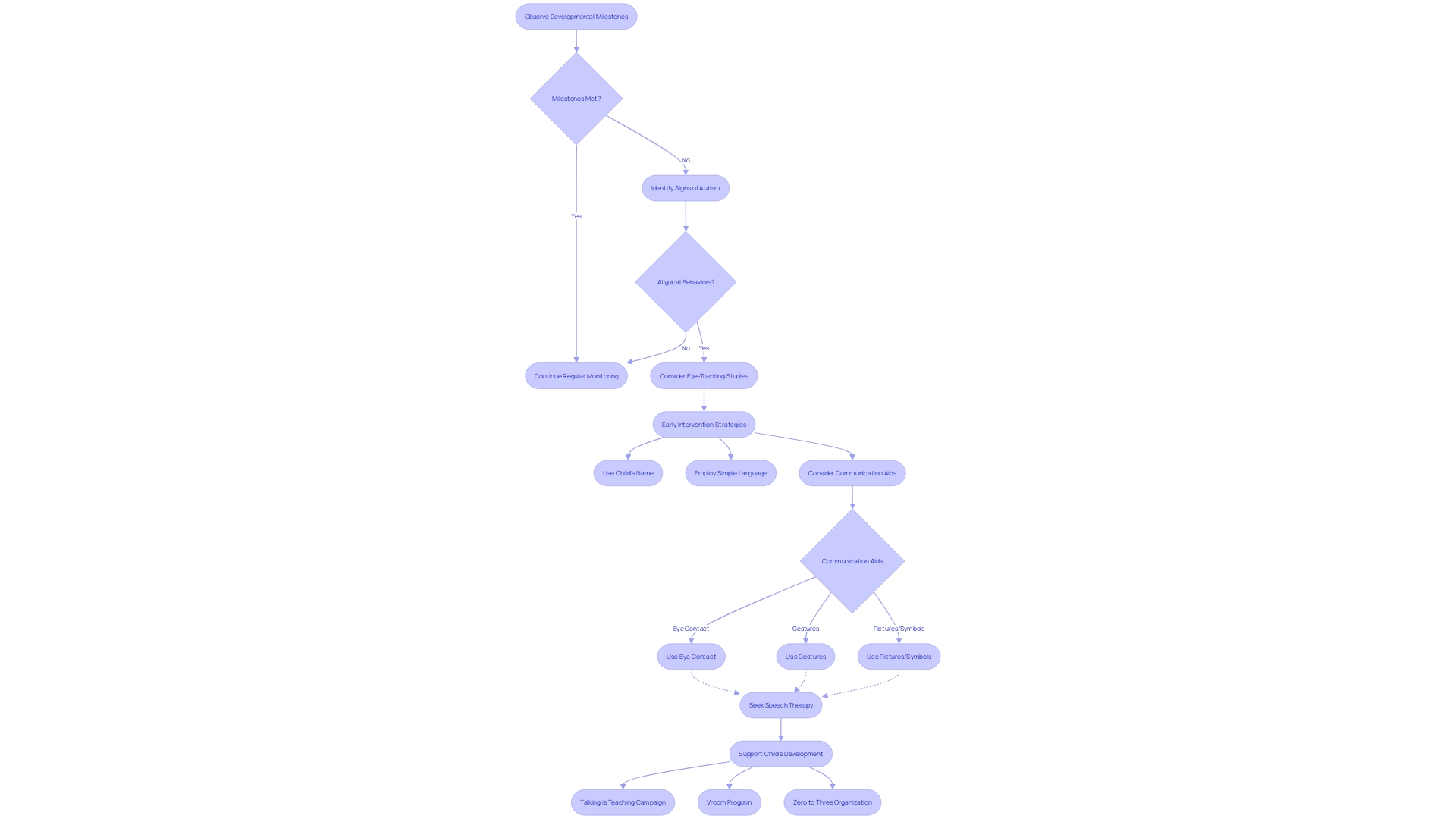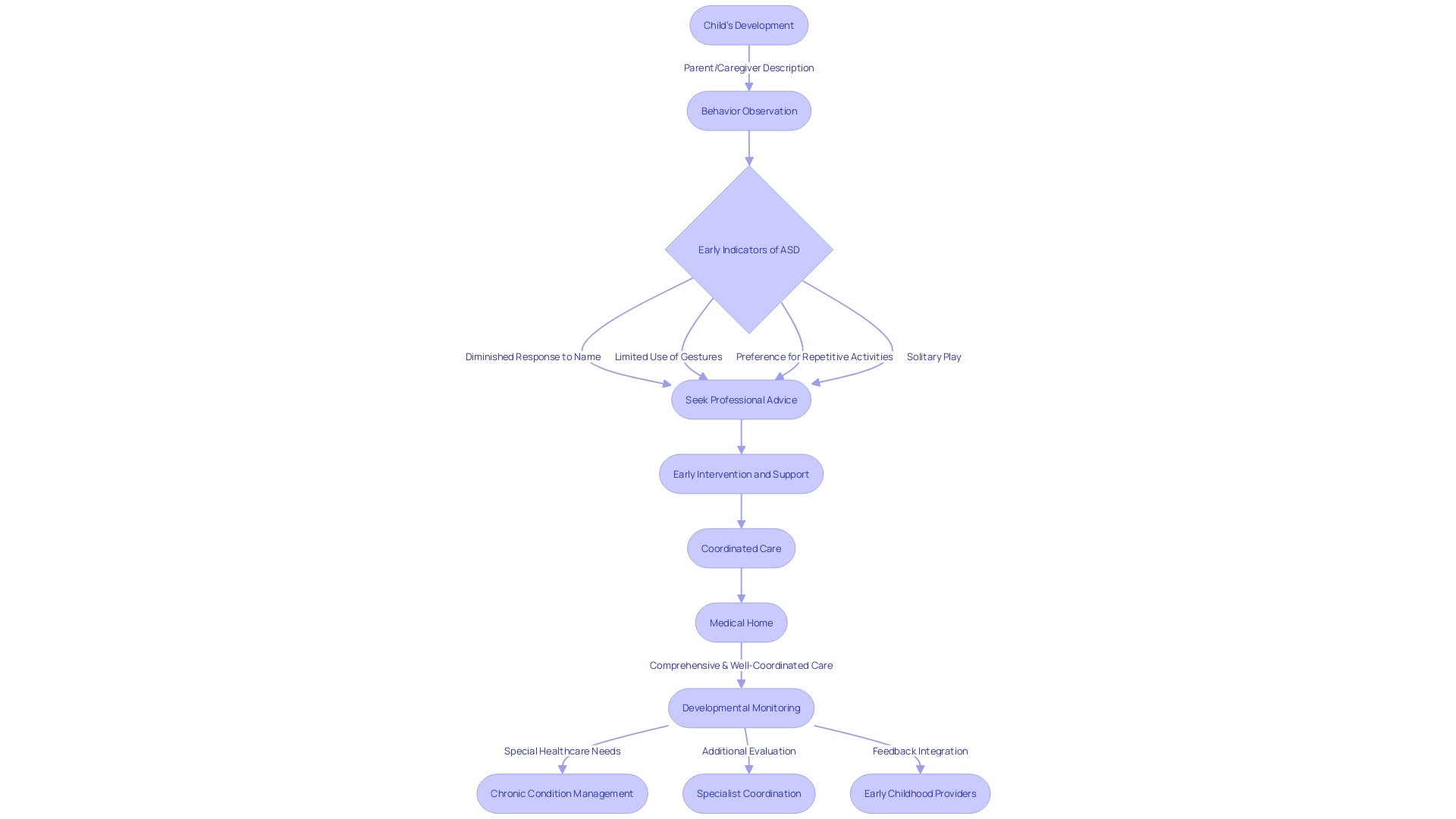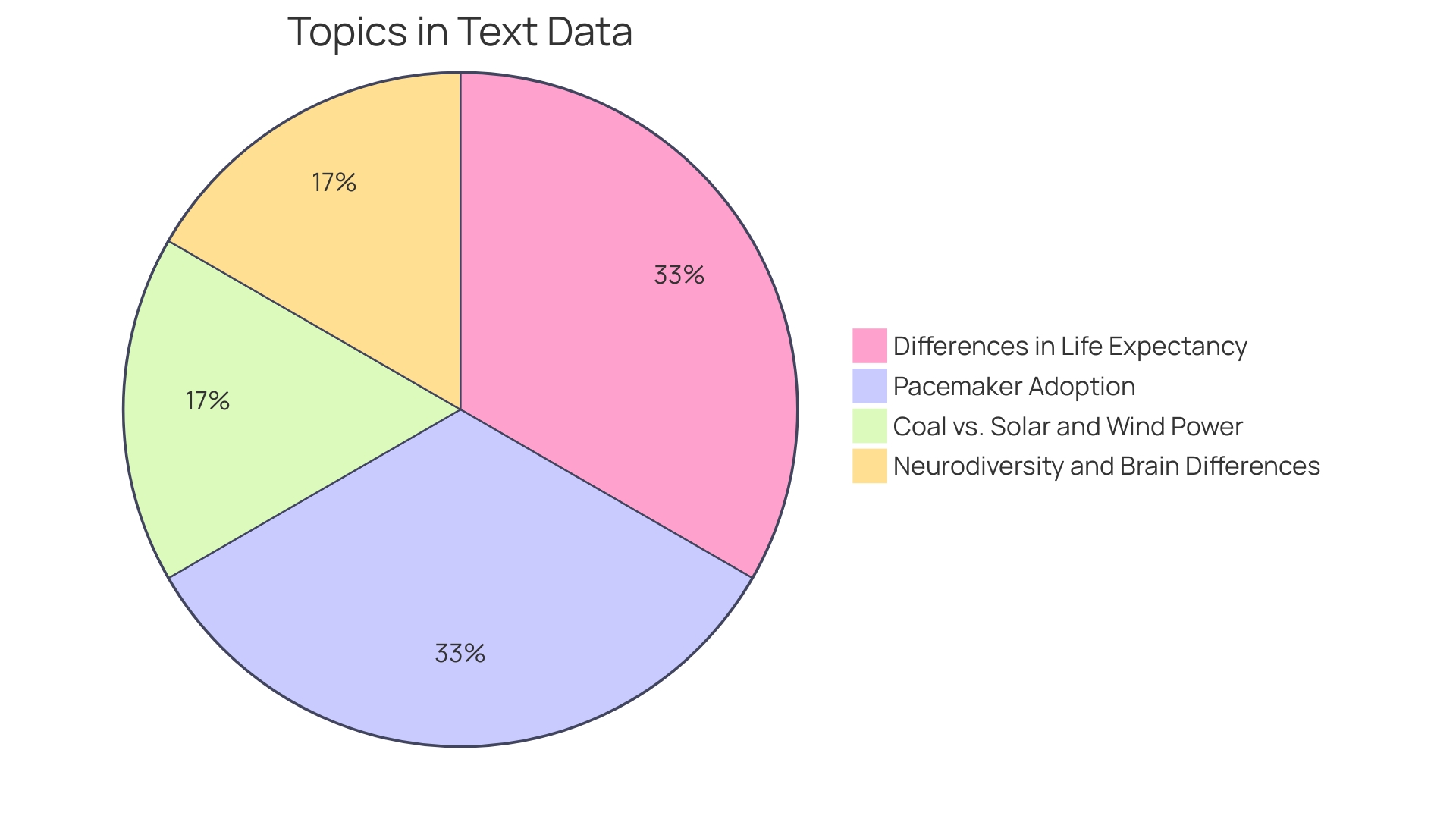Introduction
Recognizing the signs of autism early in a child's development is crucial for their future well-being. Autism Spectrum Disorder (ASD), characterized by challenges in social interaction and communication, can greatly benefit from timely interventions. Recent research has shed light on the nuanced development of autism, revealing the influence of both genetic and environmental factors.
However, the diagnostic process can be complex, leading to delays in accessing early behavioral therapies. Innovations in diagnostic tools, such as those being developed by NeuroQure, offer hope for revolutionizing early ASD detection. With autism affecting 1 in 36 children annually in the U.S., the importance of early identification and intervention cannot be overstated.
As we strive to equip children with the best start possible, understanding the early signs and symptoms of autism, utilizing screening and surveillance recommendations, and empowering parent advocates become crucial steps in ensuring the well-being and potential of children with ASD.
Why Early Identification is Crucial
The importance of early detection of autism in children cannot be overstated. With only 10-20% of individuals diagnosed before age 5 achieving independence in adulthood, recognizing the signs of Autism Spectrum Disorder (ASD) early can significantly impact a child's future. ASD, marked by challenges in social interaction, communication, and often by restricted, repetitive behaviors, can greatly benefit from timely interventions that improve language, cognitive, and adaptive skills.
Recent research, including a study from JAMA Network Open involving over 1,000 two-year-olds, has advanced our understanding of autism's nuanced development. It suggests that both genetic and environmental factors interact in real-time to influence the onset of ASD. This complexity is reflected in the diagnostic process, where a 6-site study found that 30% of young children's autism diagnoses involved some level of uncertainty.
This uncertainty often delays access to early behavioral therapies, which are known to enhance outcomes.
Innovations in diagnostic tools, like the ones being developed by NeuroQure, promise to shorten the journey to diagnosis. The company aims to offer support to families shortly after birth, rather than after years of uncertainty. Their approach, backed by a large trial at six leading autism centers, utilizes algorithms to analyze children's visual engagement with social scenes, potentially revolutionizing early ASD detection.
The stakes are high, as autism affects 1 in 36 children annually in the U.S. alone. The work of researchers like Warren Jones, PhD, and Ami Klin, PhD, focuses on 'social visual engagement'—how children interact with their social environment and how this differs in those with autism. Their findings underscore the critical need for early identification and intervention to support the health and development of children with ASD.
As we continue to unveil the intricate dynamics governing autism's emergence, the collective goal remains: to equip children with the best start possible for a fulfilling life.
Common Age of Diagnosis and Parental Concerns
Autism Spectrum Disorder (ASD) is a condition with a broad range of impacts on behavior, social skills, and communication. Recognizing the signs of autism early in a child's development is critical for accessing interventions that can significantly improve outcomes. Diagnosis typically happens during early childhood, but the process can be complex and uncertain.
Parents and caregivers often provide essential insights about a child's development, which, combined with a professional's behavioral observations, form the basis of diagnosis according to the DSM-5 criteria.
Despite advanced diagnostic tools, uncertainty remains. A 6-site study with experienced clinicians found that about 1 in 3 diagnoses in young children involved some level of uncertainty, especially for those with higher cognitive abilities or milder autism-related behaviors. This diagnostic ambiguity can delay access to critical early intervention services.
These services are designed to enhance language, cognitive, social, and adaptive skills, and the sooner they begin, the better the potential outcomes for the child.
Early identification is facilitated by new technologies, such as the automated measurement of children's looking behavior, which can predict autism diagnosis with a high degree of accuracy. This biomarker technology, often referred to as "the Marcus Test," has shown promise in clinical studies, marking a significant advancement in the early detection of autism.
The journey to diagnosis can be long and arduous, with a recent Australian Senate inquiry report indicating wait times of three to four-and-a-half years. These delays can be even longer for females with autism or those with co-occurring conditions like ADHD. The National Disability Insurance Scheme (NDIS) in Australia aims to alleviate some of these challenges by providing personalized plans and funding for early intervention, which is a key component in supporting children with autism and their families.
In summary, while challenges in diagnosing and supporting children with ASD persist, progress is being made through both improved diagnostic criteria and innovative technologies. Early intervention and support remain paramount in helping every child with autism to reach their full potential.
Early Signs and Symptoms of Autism in Infants
Recognizing developmental milestones is crucial in identifying early signs of autism in infants. These milestones cover a broad range of skills including social, emotional, language, communication, cognitive, and physical development. For instance, an infant may demonstrate atypical behaviors by avoiding eye contact, showing limited interest in social engagement, or not babbling as expected for their age.
Repetitive motions or unusual behaviors are also markers that may warrant further assessment.
Recent advancements in technology, such as eye-tracking studies, have shown promise in improving the accuracy and efficiency of autism diagnosis. Eye-tracking can provide objective insights into the development of autism from early childhood. This technique, as part of a broader diagnostic assessment, is already being used to track children's gaze patterns during social interactions, offering a quantifiable measure of their social visual engagement.
The importance of early intervention cannot be overstated, as it allows for the support of a child's health, learning, and long-term well-being. The United Kingdom's National Health Service suggests using the child's name to garner attention, employing simple language, and considering communication aids like eye contact, gestures, and pictures. Additional resources such as speech and language therapy can be invaluable for supporting children showing signs of developmental delays or autism.
By staying informed about developmental benchmarks and utilizing available technological and therapeutic resources, caregivers play a pivotal role in fostering the early development of children with autism, thereby maximizing their potential for a fulfilling life.

Behavioral Markers in Mid-Infancy
Autism Spectrum Disorder (ASD) presents early in life, but its initial symptoms can be subtle. During the critical period of mid-infancy, certain behaviors such as diminished response to their name, limited use of gestures like pointing, and a pronounced preference for repetitive activities or solitary play can be early indicators of autism. Recognizing these signs promptly is vital.
As underscored by recent research, early diagnosis is paramount, transitioning from potential risk to observable symptoms. This early recognition can lead to beneficial early intervention, thus enhancing life outcomes. Studies have shown that only a fraction of individuals diagnosed with ASD before the age of five can lead independent lives in adulthood, reinforcing the importance of vigilant observation during early development.
Groundbreaking tools like the 'Marcus Test' leverage technology to predict autism by analyzing eye movement and social engagement, indicating a push towards more precise and earlier detection. Understanding these behavioral markers and seeking professional advice could steer toward a more informed approach to care and support, towards improving quality of life for those with ASD as they grow.

Play Behaviors as Early Indicators
Observing a child's interaction with their environment, particularly through play, can be a powerful window into their developmental progress. For instance, infants who are on the autism spectrum may show distinct patterns in play behavior. They might demonstrate limited engagement in pretend play or show a strong preference for repetitive activities over more varied forms of play.
Additionally, these children could find it challenging to participate in interactive play with peers or caregivers, preferring solitary activities instead. It's essential for those caring for children to be vigilant about these early signs and to consult with a professional if there are any concerns about a child's play patterns or overall development. Recent studies have emphasized the critical role of early detection and intervention in supporting children with autism.
With groundbreaking research exploring the intricacies of cognitive development in infants and the importance of early social engagement, experts are now able to better understand and support the unique developmental trajectories of children with autism.
Screening and Surveillance Recommendations
Understanding the nuances of autism spectrum disorder (ASD) and its early signs is crucial for proactively addressing the needs of those affected. The journey from the risk factors to the manifestation of ASD symptoms is a complex interplay of genetics and environmental influences. With studies revealing that only a small fraction of individuals diagnosed with ASD before five years of age can live independently in adulthood, the significance of early detection and intervention cannot be overstated.
Screenings for ASD involve monitoring a child's development closely to pinpoint any deviations from typical growth patterns. These evaluations are not always straightforward; a study involving 496 children aged 16 to 30 months at specialized centers found that 70.2% of autism diagnoses carried a high level of certainty. That leaves a considerable number of cases where diagnosis is less clear-cut, particularly in children with higher cognitive and language abilities.
Early identification is a pivotal step that can lead to access to behavioral therapies, which have shown promise in enhancing language, cognitive, social, and adaptive skills.
Innovative diagnostic methods are emerging, such as those utilizing automated devices to measure children's eye movements while they watch social interactions, achieving notable accuracy rates. Such technologies are being developed based on extensive research, including trials at leading autism centers. The goal is to ensure that children with ASD begin receiving support as soon as possible, paving the way for better long-term outcomes.
The commitment to advance autism diagnosis and treatment is echoed by organizations like The Autism Community in Action and federal advisory committees like the IACC, which strive to foster research and services for the autism community. With the promise of new tools capable of detecting ASD from an early age, there is hope for more timely interventions and improved quality of life for those on the autism spectrum.

Strategies for Parent Advocates: Monitoring and Interventions
Parental involvement is crucial in shaping their child's early life experiences, especially during the first 1,000 days, which is a critical period for brain development. This phase lays the groundwork for a child's future well-being. However, disparities exist, with children from lower socioeconomic backgrounds often lacking high-quality early learning environments, which can impact their developmental milestones.
Supporting these early experiences is paramount, as Dr. David (Dan) R. Offord highlighted, aiming for equity and fair opportunities for all children, including those with disabilities or high-risk backgrounds like those affected by COVID-19.
The role of parents in monitoring and guiding their children's development cannot be overstated. With more than 265,000 children having lost a parent or caregiver to COVID-19, the need for parental guidance is more acute than ever. The pandemic has further exacerbated challenges, particularly for minoritized communities.
It is essential for parents to be vigilant about their child's developmental milestones and seek professional advice if there are concerns. Collaborating with professionals is key in devising and implementing effective interventions.
Research underscores the importance of programs led by parents with lived experiences in child protective services. Such programs, catering to the needs of parents currently involved with CPS, have shown positive outcomes. They focus on empowering parents to influence service delivery and policy-making, contributing to a family-centered practice that is sensitive to their unique situations.
This collaborative approach aligns with the UNCRC's stipulation that every child deserves protection and a safe environment conducive to healthy development.
Ultimately, parents play a decisive role in creating equitable conditions for their children's growth and ensuring their voices are heard in shaping the services they receive. By acknowledging the assets and addressing the unmet needs of children, particularly those with disabilities or emotional and behavioral problems, parents can foster an inclusive environment that supports every child's right to participate meaningfully in their communities.
Navigating the Diagnostic Process
For those helping children on the path toward an autism diagnosis, the journey can be daunting. The road to diagnosis often starts with a suspicion or concern, leading to consultations with a variety of healthcare professionals. As families navigate evaluations and assessments, they must assemble information, formulate questions, and actively advocate for their child.
The process is not without its challenges; recent research indicates that the wait for an autism diagnosis can span several years, with a Senate inquiry underscoring the particularly lengthy waits for ADHD and autism assessments.
The gender disparity in diagnosis times is also noteworthy. Studies show that females are frequently diagnosed later than males, especially when they also have ADHD, pointing to a need for greater awareness and refined diagnostic criteria. This lag in diagnosis can delay crucial early intervention, which has been consistently linked to better outcomes.
Amidst these complexities, some individuals within the autistic and neurodivergent community support self-diagnosis due to the limitations and inconclusiveness of medical testing. For those who find that an official diagnosis wouldn't change their support needs, enduring the extensive and often costly diagnostic process may not seem necessary. Yet, for others, an official diagnosis is a validation that can aid in securing services and fostering understanding from others.
Support networks play a critical role during this time. Organizations like The Autism Community in Action (TACA) provide resources and assistance to thousands of families, advocating for the development of diagnostic tools that could identify autism spectrum disorder (ASD) at an early age. With strategies and policies in motion, such as Australia's National Autism Strategy and the National Disability Insurance Scheme (NDIS), there is a push for better access to services and support.
However, the effectiveness of these initiatives is under scrutiny, as some suggest that they may inadvertently contribute to the surge in autism diagnoses.
In light of these revelations, families and caregivers must remain informed and vigilant. Continuous research into treatments, medications, and therapeutic approaches is crucial. While the internet is a vast resource, discerning credible information from misleading narratives is essential.
Ultimately, balancing hope with critical evaluation of potential therapies is key to navigating the complex landscape of autism diagnosis and care.
Importance of Early Intervention and Access to Services
Understanding that every child deserves a fair start, early intervention for children with autism is akin to setting the stage for a more equitable race. It's pivotal for parent advocates to recognize the impact of timely and tailored services, such as speech and occupational therapy, along with behavioral interventions, in fostering their child's potential. These services are not just about addressing challenges; they celebrate and build upon each child's unique strengths.
By partnering with professionals, parents can co-create an individualized plan that nurtures their child's development. This collaborative approach is essential in reducing stress for the child and the family, supporting mental health, and enhancing the child's ability to engage in school and community life. Moreover, this proactive stance helps to bridge the gap in healthcare equity, ensuring that children, regardless of their background, can access the care they need without undue delay.
The goal is to ensure that every child with autism is included, supported, and equipped to thrive in all aspects of life.
Conclusion
Early identification of autism is crucial for a child's future well-being. Autism Spectrum Disorder (ASD) can greatly benefit from timely interventions, but the diagnostic process can be complex, leading to delays in accessing early behavioral therapies. Innovations in diagnostic tools, like those being developed by NeuroQure, offer hope for revolutionizing early ASD detection.
With autism affecting 1 in 36 children annually in the U.S., early identification and intervention are essential.
Recent advancements in technology, such as the automated measurement of children's looking behavior, have shown promise in improving the accuracy and efficiency of autism diagnosis. The Marcus Test, which analyzes eye movement and social engagement, marks a significant advancement in early detection. Observing a child's play behaviors can also provide valuable insights into their developmental progress, with limited engagement in pretend play, a preference for repetitive activities, and challenges in interactive play serving as early indicators of autism.
Screenings and surveillance recommendations play a crucial role in proactively addressing the needs of children with autism. Early identification leads to access to behavioral therapies, enhancing language, cognitive, social, and adaptive skills. Parental involvement is vital in shaping a child's early life experiences.
Monitoring developmental milestones, seeking professional advice, and collaborating with professionals are key in implementing effective interventions.
While the diagnostic process may be daunting, the support of organizations like The Autism Community in Action (TACA) and the development of diagnostic tools can help families navigate the journey more effectively. Early intervention and access to services are essential in setting the stage for a child's future. By partnering with professionals and co-creating individualized plans, parents can nurture their child's development and bridge the gap in healthcare equity.
The goal is to ensure that every child with autism is included, supported, and equipped to thrive in all aspects of life. With early identification, intervention, and the collective efforts of parents, professionals, and organizations, we can empower children with autism to reach their full potential. Together, we can make a difference in the lives of these children, providing them with the best start possible and ensuring their well-being and success.




